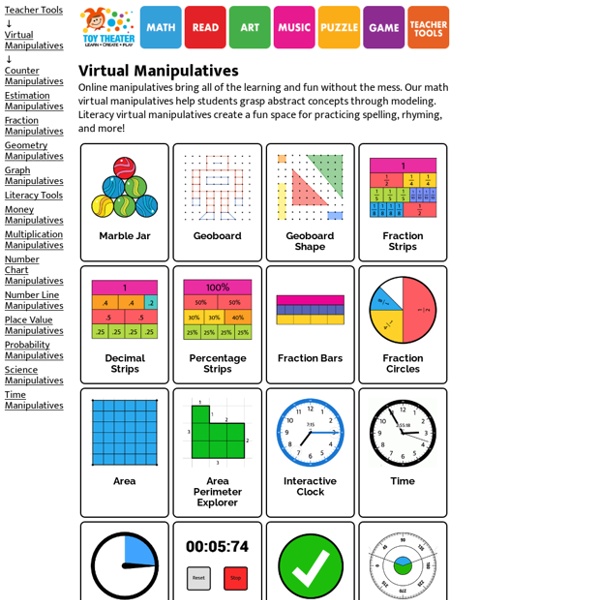A Collection of Virtual Math Manipulatives
I have compiled some of my favorite virtual math manipulative web apps in this one resource that I hope you and your students can use this year! 👆You can share that link in Google Classroom, Seesaw, your LMS, etc. Students will be able to click on the laptops to visit five different virtual manipulative sites. The individual manipulatives that appear on the bookshelf are also hyperlinked to that specific tool.
Key-Lock Puzzle
© CPM Educational Program 2014 Welcome to the key-lock puzzle! With this tool, you can explore the effects of the three different kinds of rigid transformations: translation, rotation, and reflection. You may also use this tool to create new puzzles where the goal is to use rigid transformations to move the key or triangle from its start position to a goal while avoiding obstacles. Click on 'Next ▶' below to get started! Click on 'Page X of Y' below at any time to see the table of contents.
A Different Kind of Multiplication
It is often said that an important advantage of the decimal notation over the Roman one is that makes multiplication of numbers much easier. Adding CLXXVII to XXIII may be relatively straightforward--but how about multiplying the two? It is indeed easier to multiply these as decimal numbers 177 by 23, but the Romans also had a multiplication method of their own.
Online Math Manipulatives - The Brown Bag Teacher
From cuisenaire rods to base-ten pieces, manipulatives are a CRITICAL part of our primary classrooms. They offer students a real, hands-on way to explore a mathematical concept and build their own meaning. The CSA model of mathematics has us moving students from the concrete to the semi-concrete to the abstract when introducing and teaching new material. When students are struggling at the representational/abstract level, we always move back and build concrete experiences with mathematics. Students need hands-on ways to interact with math.
7 Super Screencasting Activities for School
Screencasting tools are a popular option for use in schools. At their most basic they allow you to record a video of what is on your computer screen, along with your voice, and depending on the program perhaps your webcam as well. Some may go further to provide you with annotation tools to write on or highlight portions of the screen while recording.
Math Games – building a foundation for mathematical reasoning
In 2001, the National Research Council, in their report Adding it up: Helping children learn mathematics, sought to address a concern expressed by many Americans: that too few students in our schools are successfully acquiring the mathematical knowledge, skill, and confidence they need to use the mathematics they have learned.Developing Mathematical ProficiencyThe potential of different types of tasks for student learning, 2017 As we start a new school year, I expect many teachers, schools and districts to begin conversations surrounding assessment and wondering how to start learning given students who might be “behind”. I’ve shared my thoughts about how we should NOT start a school year, but I wanted to offer some alternatives in this post surrounding a piece often overlooked — our students’ confidence (including student agency, ownership and identity). When we hear ideals like the above quote, what many of us see is as missing are specific examples. How to Play: Like this:
Eratosthenes Experiment 2019
Eratosthenes was a talented mathematician and geographer as well as an astronomer. He made several other important contributions to science. Eratosthenes devised a system of latitude and longitude, and a calendar that included leap years. He invented the armillary sphere, a mechanical device used by early astronomers to demonstrate and predict the apparent motions of the stars in the sky.
guessing — ore_algebra 0.1 documentation
Guesses recurrence or differential equations for a given sample of terms. data – list of termsA – an Ore algebra of recurrence operators, differential operators, or q-differential operators.order – maximum order of the sought operatorsdegree – maximum degree of the sought operatorslift (optional) – a function to be applied to the terms in data prior to computationsolver (optional) – a function to be used to compute the nullspace of a matrix with entries in the base ring of the base ring of Acut (optional) – if \(N\) is the minimum number of terms needed for the the specified order and degree and len(data) is more than N+cut, use data[:N+cut] instead of data. This must be a nonnegative integer or None.ensure (optional) – if \(N\) is the minimum number of terms needed for the specified order and degree and len(data) is less than N+ensure, raise an error. An error is raised in the following situations: Ansatz and linear algebra.
1st Grade Math Games and Videos
Practice counting skills in this fun online game. Find the matching cards. Count up the leaves shown and find the card that shows the same number.
Meet Google Drive – One place for all your files
One account. All of Google. Sign in to continue to Google Drive Find my account
Multiplication by Heart – Mathigon
Rote memorization of multiplication facts is often disconnected, boring, and hard. Multiplication by Heart was designed to help you master multiplication facts in a meaningful, connected way. Using the flash cards for five minutes per day will help you understand multiplication and achieve true fluency.
Adding and Subtracting Positive and Negative Numbers
Numbers Can be Positive or Negative This is the Number Line: If a number has no sign it usually means that it is a positive number. Balloons and Weights
Darij Grinberg
This is a website for mathematics, elementary and advanced (mostly algebra and combinatorics). Solutions to review problems (Some problems from American Mathematical Monthly and other sources, with my solutions.) The notes below have been written for various purposes, and are sorted by expected usefulness (i.e., the first in the list are probably the most useful).



